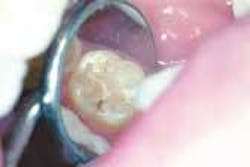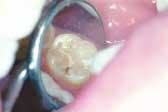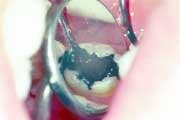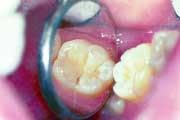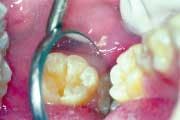HOW TO PROFIT FROM…microdentistry: Substituting air-abraision techniques for sealants
By J. Tim Rainey, DDS, MAGD
In the past few years, operative-dentistry techniques have focused on minimal invasiveness and sacrifice of sound tooth structure. As new techniques emerge and are adapted into dental disciplines, the intent and purpose of the original technology often changes. Air abrasion is an old dental technology that is finding a new place in modern, science-based microdentistry, redefined from the original applications of the 1950s when dental education was dedicated to preserving the dogma and theories of prevention.
As an adjunct to microdentistry, air abrasion is now supported in the literature as the accepted alternative to traditional rotary instrumentation. According to Ferdianakis and White in a controlled study comparing air abrasion to other treatment modalities, "the trials revealed that for small or moderate cavities, the optimal method of preparation, especially for children, is with air-abrasion." The authors went on to say that "the presence of chamfer does not have any negative effects on microleakage formation and, in contrast, can increase the surface adherence, which may contribute to microleakage reduction."
In many studies, the two things patients most disliked about dentistry were the use of the needle and drill. The new microabrasion technology and its associated new techniques of air abrasion are tailor-made to frequently eliminate the need for the high-speed drill and local anesthesia. Air abrasion eliminates objectionable heat, sound, and vibrations associated with high-speed instrumentation. Still another benefit is the elimination of the recognized side effects of microfracture and microcrazing of the enamel margins and the enamel in general. It also is unnecessary to destroy important structural and substructural components when utilizing micro air-abrasion-assisted microbonding techniques. This helps maintain the biomechanical integrity of the occlusal surface.
Although I have been utilizing the concepts of microdentistry in our busy practice for more than 17 years, I still am amazed by the amount of fissure caries detected with caries-detection dye or with a diagnostic laser, particularly in newly-erupted teeth. The diagnostic technology of this past century relied on the familiar dental pick, the dentist's visual skills, and his or her ability to "feel" decay. These techniques, although still taught as part of the standard dental curriculum, have been proven time and again to be woefully inaccurate for diagnosing the early presence of decay. In fact, this old technology is only about 25 percent accurate in the detection of decay, which is a contributing factor to sealant failure. Decay is difficult to seal over, as indicated by data showing higher failure rates as the DMF increases.
Early detection of caries in newly erupted teeth has spilled over into our general practice. Every aspect of our restorative practice is now augmented by early detection, improved by the routine use of electronic enhancement of radiographs during the diagnostic phase, and aided by air abrasion during the restorative phase. Our daily encounter of previously undiagnosable caries in our established patients proves beyond any doubt to be the caries I used to miss and the caries I used to seal over. A full 25 percent of our practice comes from early diagnosis and intervention - a service that our patients understand and expect. In fact, some 50 percent of our practice income comes from patients who live 50 miles or more from our rural location.
Since the introduction of fluoridation, outwardly detectable decay has been dramatically reduced. Because of the strengthening that fluoride creates in the outer layer of tooth enamel, the pattern of decay has changed. Rather than large areas of a tooth surface succumbing to the attack of plaque acid, decay now appears as small discreet areas, often undetectable to the dental probe, yet visible as a color change inside the tooth under magnification. Dentists have observed this change, and have continued to develop a science based on prevention and protection and the continuing miniaturization of all treatment procedures. New filling and restorative materials and techniques also have been developed. The new techniques require early and aggressive investigation of stains, the targeted removal of unsound tooth structure vs. the indiscriminate removal of sound tooth structure, and bonded restorations rather than traditional "drill, fill, and bill" approaches.
Sealants - once the staple of many practices catering to the young - have fallen by the wayside in our practice, discarded for the more accurate operative technique of early diagnosis and selective removal of decay by air abrasion. The use of sealants in the past cannot be criticized, any more than we can criticize any other technology that was the best for any given period of time. General Motors never apologizes for last year's Cadillacs!
The entire philosophy of placing sealants was developed around the fact that the diagnostic technology available to dentists in the 1960s and the 1970s was unreliable. Placement of traditional fillings had disastrous consequences, since the average life expectancy of a traditional restoration placed by anesthetizing the patient, drilling out massive amounts of healthy tooth structure, and then placing an amalgam restoration is only about 14 years, at best. Indeed, more than 70 percent of what we, as dentists, do on an average day is simply repairing the damage done to teeth by old filling technology!
Many dental practices consider the hygiene department's daily charges or "production" of sealants as an essential part of the daily practice income. But, dentists should first consider the patient's best interest, which includes placement of restorations that require minimum maintenance. Rather than focusing on having the hygienist place sealants on patients who may or may not show up again every three years, we should consider the economic impact of substituting a more predictable procedure, by utilizing air abrasion for early intervention in decay. In addition to the economic benefit to the patient from using a more predictable procedure, it makes more economic sense to better utilize the valuable time of the hygienist in conducting a more thorough patient examination. The hygienist can accomplish this with video diagnosis, aided by high-resolution intraoral video camera and video capture and laser and dye caries detection.
In a nutshell, mounting scientific evidence indicates that unless sealants are meticulously maintained, eventual failure is the norm. Christensen, Ploeger, and Palmer recently studied 159 teeth in young adults that had sealants placed 10 years earlier. This study showed that "92 percent of the teeth were carious, and 26 percent of that group had large, deep, carious lesions penetrating greater than 3 mm and not evident in radiographs or clinically."
This evidence also raises several issues that can be boiled down to one question: "Why not do it right the first time?" If sealants must be meticulously maintained to assure even marginal rates of success - as indicated by the fact that resurfacing is now recommended every three years - then the financial savings rapidly evaporate when you factor in that somebody must pay to maintain them.
Because the failure rate among sealants is so high, we meticulously examine each sealant our patients have. The examination includes placing a caries-detection dye on the sealants using high resolution video-imaging. If a sealant is leaking, good magnification will show the tint of the dye under the sealant. A failed sealant is then easily removed, utilizing the parallel water stream technique. The operative field is flooded with water, while air abrasion is simultaneously used to selectively remove the sealant.
Micro-air abrasion increases profits to the dentist by providing more aesthetic restorations with greater patient acceptance due to the reduced need for local anesthetic. Highly destructive traditional preparations are no longer necessary when adhesive technology is utilized.
Patients are showing a great demand for conservative dentistry. Micro air abrasion has opened up a whole new method of treatment for them that preserves far more tooth structure than was ever previously possible. The resulting surfaces also are better prepared to receive and retain bonded restorations, compared to previous traditional methods of preparation.
Microdentistry and the adjunct micro air-abrasion technology have caught the public's eye. When Environics - a Canadian pollster group equivalent to the Harris Poll - polled the Canadian public, results showed that 60 percent were very interested in the concept of microdentistry and an additional 24 percent were somewhat interested. That means that 84 percent of the total respondents had some level of interest in microabrasion! These are extremely high levels of interest, and they indicate a significant potential for micro-dentistry.
Jerry Ross, a well-known Canadian microdentist, best summed up his approach this way: "Air-abrasive microdentistry is a technology whose time has arrived and [it] can be one of the most significant advances in the history of dentistry. It will allow us to create a generation who will never need the extensive dentistry that previous generations have experienced. It will complete the promise that fluoride and sealants have offered."
